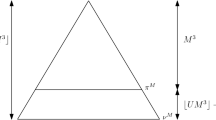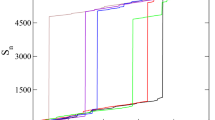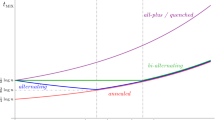Abstract
The Swendsen–Wang process provides one possible dynamics for the q-state Potts model. Computer simulations of this process are widely used to estimate the expectations of various observables (random variables) of a Potts system in the equilibrium (or Gibbs) distribution. The legitimacy of such simulations depends on the rate of convergence of the process to equilibrium, as measured by the “mixing time.” Empirical observations suggest that the mixing time of the Swendsen–Wang process is short in many instances of practical interest, although proofs of this desirable behavior are known only for some very special cases. Nevertheless, we show that there are occasions when the mixing time of the Swendsen–Wang process is exponential in the size of the system. This undesirable behavior is related to the phenomenon of first-order phase transitions in Potts systems with q > 2 states.
Similar content being viewed by others
REFERENCES
F. Barahona, On the computational complexity of Ising spin glass models, J. Phys. A: Math. Gen. 15:3241-3253 (1982).
R. J. Baxter, Exactly Solved Models in Statistical Mechanics (Academic Press, London, 1982).
B. Bollobás, Random Graphs (Academic Press, London, 1985).
B. Bollobás, G. Grimmett, and S. Janson, The random-cluster model on the complete graph, Prob. The. Rel. Fields 104:283-317 (1996).
R. Bubley and M. Dyer, Path coupling: A technique for proving rapid mixing in Markov chains, Proceedings of the 38th Annual IEEE Symposium on Foundations of Computer Science (Computer Society Press, 1997), pp. 223-231.
R. Bubley, M. Dyer, and C. Greenhill, Beating the 2Δ bound for approximately counting colourings: A computer-assisted proof of rapid mixing, Proceedings of the Ninth Annual ACM-SIAM Symposium on Discrete Algorithms (SODA), ACM-SIAM (1998), pp. 355-363.
Colin Cooper and Alan M. Frieze, Mixing properties of the Swendsen-Wang process on classes of graphs. To appear in Proceedings of a DIMACS Workshop on Statistical Physics Methods in Discrete Probability, Combinatorics and Theoretical Computer Science, Jennifer T. Chayes and Dana Randall, eds. (American Mathematical Society).
R. G. Edwards and A. D. Sokal, Generalizations of the Fortuin-Kasteleyn-Swendsen-Wang representation and Monte Carlo algorithm, Phys. Rev. D 38:2009-2012 (1988).
R. S. Ellis, Entropy, Large Deviations, and Statistical Mechanics, Grundlehren der mathematischen Wissenschaften, Vol. 271 (Springer-Verlag, 1985).
C. M. Fortuin and P. W. Kasteleyn, On the random cluster model I: Introduction and relation to other models, Physica 57:536-564 (1972).
V. Gore and M. Jerrum, The Swendsen-Wang process does not always mix rapidly, Proceedings of the 29th ACM Symposium on Theory of Computation (ACM Press, 1997), pp. 674-681.
M. Jerrum and A. Sinclair, Polynomial-time approximation algorithms for the Ising model, SIAM J. Comput. 22:1087-1116 (1993).
M. Jerrum, A very simple algorithm for estimating the number of k-colourings of a low-degree graph, Random Structures and Algorithms 7:157-165 (1995).
M. Jerrum and A. Sinclair, The Markov chain Monte Carlo method: An approach to approximate counting and integration. In Approximation Algorithms for NP-hard Problems, Dorit Hochbaum, ed. (PWS, 1996), pp. 482-520.
R. Kannan, Markov chains and polynomial time algorithms. Proceedings of the 35th Annual IEEE Symposium on Foundations of Computer Science (Computer Society Press, 1994), pp. 656-671.
R. M. Karp and M. Luby, Monte-Carlo algorithms for enumeration and reliability problems, Proceedings of the 24th IEEE Symposium on Foundations of Computer Science (Computer Society Press, 1983), 56-64.
R. M. Karp, The transitive closure of a random digraph, Random Structures and Algorithms 1:73-93 (1990).
H. Kesten and R. H. Schonmann, Behavior in large dimensions of the Potts and Heisenberg models, Rev. Math. Phys. 1:147-182 (1990).
L. Laanait, A. Messager, S. Miracle-Sole, J. Ruiz, and S. Shlosman, Interfaces in the Potts model I: Piragov-Sinai theory of the Fortuin-Kasteleyn representation, Commun. Math. Phys. 140:81-91 (1991).
C. McDiarmid, On the method of bounded differences, London Mathematical Society Lecture Note Series, Vol. 141 (Cambridge University Press, 1989), pp. 148-188.
P. Martin, Potts Models and Related Problems in Statistical Mechanics (World Scientific, Singapore, 1991).
N. Metropolis, A. W. Rosenbluth, M. N. Rosenbluth, A. H. Teller, and E. Teller, Equation of state calculations by fast computing machines, J. Chem. Phys. 21:1087-1092 (1953).
R. Motwani and P. Raghavan, Randomized Algorithms (Cambridge University Press, 1995).
Neil O'Connell, Some large deviation results for sparse random graphs, Prob. Theo. Rel. Fields 110:277-285 (1998).
R. B. Potts, Some generalised order-disorder transformations, Proc. Cambridge Phil. Soc. 48:106-109 (1952).
J. Salas and A. D. Sokal, Absence of phase transition for antiferromagnetic Potts models via the Dobrushin uniqueness theorem, J. Stat. Phys. 86:551-579 (1997).
Alistair Sinclair, Improved bounds for mixing rates of Markov chains and multicommodity flows, Combin. Prob. Comput. 1:351-370 (1992).
A. Sokal, Personal communication (1995).
R. H. Swendsen and J.-S. Wang, Non-universal critical dynamics in Monte-Carlo simulations, Phys. Rev. Lett. 58:86-88 (1987).
D. J. A. Welsh, The computational complexity of some classical problems from statistical physics. In Disorder in Physical Systems (Oxford University Press, 1990), pp. 307-321.
D. J. A. Welsh, Complexity: Knots, colourings and counting, London Mathematical Society Lecture Notes, Vol. 186 (Cambridge University Press, 1993).
Author information
Authors and Affiliations
Rights and permissions
About this article
Cite this article
Gore, V.K., Jerrum, M.R. The Swendsen–Wang Process Does Not Always Mix Rapidly. Journal of Statistical Physics 97, 67–86 (1999). https://doi.org/10.1023/A:1004610900745
Issue Date:
DOI: https://doi.org/10.1023/A:1004610900745




